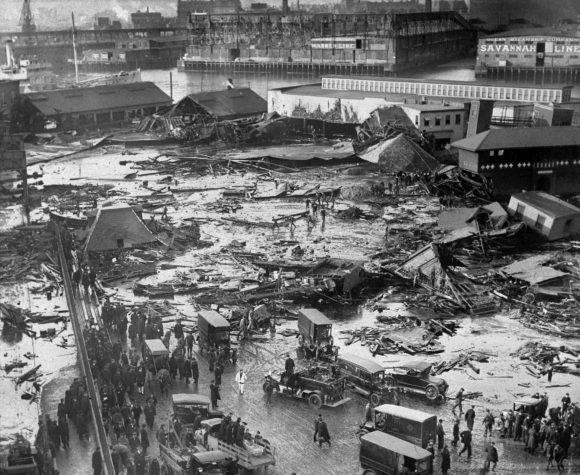


Completion occurred in 1917 and it went into operational use with little testing applied. The tank’s construction began in 1915, but it suffered delays.

The tank site was adjacent to a wharf where longshoremen could unload molasses tankers arriving from sugar cane plantations in the West Indies, pump the slurry mix to the receptacle, and then load it into rail cars when needed by USIA’s Purity distillery in Cambridge, west of downtown Boston. It’s now a public place called Langone Park. Through Purity Distilling, USIA owned a strategic location on Commercial Street at Boston’s north end waterfront. Molasses was a staple source for both, and Boston was an ideal spot for storing molasses. Alcohol was in huge demand, both recreational for making spirits and industrial for manufacturing explosives. concluded World War I efforts two months earlier and was on the verge of Prohibition being enacted.

In January 1919, Boston was a happening place. At the time, the Boston molasses tank was the city’s largest liquid storage facility. It was 50 feet tall (five stories), 90 feet in diameter, and had a circumference of 283 feet. The molasses tank (reservoir or container, if you will) belonged to the Purity Distillery Company owned by United States Industrial Alcohol (USIA). Sadly, the Boston Molasses Disaster, or Boston Molasses Flood, was perfectly preventable. Property damage was in the millions, and the legal outcome changed business practices across America. When the sugary flood stopped, 21 people were dead and over 150 suffered injuries. The sickly sweet wave was 40 feet high and moved at 35 miles per hour. 2.3 million gallons of liquid sludge, weighing over 12,000 tons, burst from the receptacle and sent a surge of brown death onto Boston’s streets. Some of the good results of the Boston Molasses Flood were improved engineering safety standards, such as the use of stamp plans (documenting changes during construction), architects authorizing all work, and more observation during theĬonstruction process.A massive molasses storage tank ruptured in downtown Boston, Massachusetts at 12:40 pm on Wednesday, January 15, 1919. 'high water mark' of the molasses is easily discernable upon the stone walls and steps of the park." The collapse of two houses on Commercial st, both wooden structures, is explained on the theory that when the sea of molasses flooded across the street with a rush, slapping against the stone wall of theĬopps Hill section of North End Park to a height of 15 feet, the cellars were flooded and the receding tide of molasses carried the buildings off their foundations and caused them to collapse. Intended to sustain a great lateral pressure. The JanuBoston Globe describes the initial investigation into the cause of the tank collapse: "The lack of evidence of an or the expansion of the lower stratas of the molasses has led the investigators toīelieve that the damage done to the Elevated structure on Commercial st was what would naturally be expected when a section of the steel tank weighing tons was swept against the upright pillars, designed to sustain an enormous weight, but not The tank's owner had claimed an anarchist had blown it up, which was It was unusual for such suits to be successful back then. A class action lawsuit was filed, and $628,000 was eventually awarded to the victims, a large sum at that time. The flood was tragic because many innocent people were killed, including a Boston firefighter who slowly drowned in the molasses, having been trapped in the debris in a nearby damagedįirehouse. The Boston Molasses Flood was historic for several reasons. (rivet strength was not checked as an example). The tank had been hastily constructed 3 years earlier, and proper design and construction standards were not followed A final batch of molasses for rum production arrived in November 1918-the ill-fated shipment. Plans were made by the tank owners to convert their East Cambridge plant from the production of rum over to Constitution in 1919, and molasses is used in the manufacture of rum. Prohibition of alcohol consumption was being amended to the U.S. This event became known as the Boston Molasses Flood. The tank was five stories high, and contained 2.3 million gallons of molasses. Value of all property destroyed was around $1,000,000. About twenty-one people were killed, and 150 people were injured. On January 15, 1919, a huge storage tank of molasses exploded without warning, and caused a wave of molasses and debris to travel down Commercial Street at 35 miles per hour. Home > Disasters Boston Molasses Flood, 1919


 0 kommentar(er)
0 kommentar(er)
